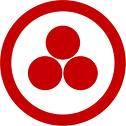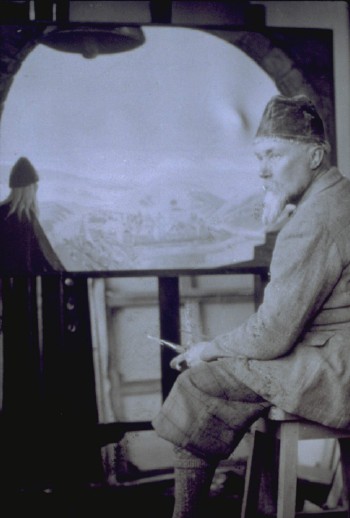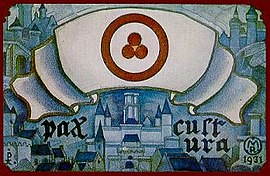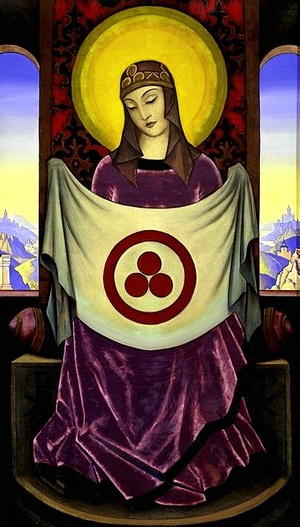 .........
.........
A boy named Nicholas was born on October 9, 1874, in St. Petersburg, Russia, to the family of a notary, Konstantin F. Roerich.
Nicholas spent his childhood in a house on the bank of the river Neva and at the suburban estate of his father, which was called Izvara. Everything interested the inquisitive boy: complex designs of the ship masts, a small boat ploughing the flat surface of the river, the words of an ancient song of the times about Tsar Peter the Great (which his grandmother would sing to the children).
inquisitive boy: complex designs of the ship masts, a small boat ploughing the flat surface of the river, the words of an ancient song of the times about Tsar Peter the Great (which his grandmother would sing to the children).
The interests of the boy were quite diverse. He learned to read very early and was fond of literature, poetry and theater. The boy also painted with enthusiasm.
As an adult,Nicholas had many projects during his life which he hoped would help to raise the consciousness of humanity. One of his best known was his Banner of Peace.
"N. Roerich included in the broad notion of Culture a synthesis of the best achievements of human spirit in the sphere of religious experience, science, art, education. Nicholas Roerich formulated the principal difference between Culture and civilization. While Culture relates to the spiritual world of man in his creative self-expression, civilization is just external arrangement of human life in all its material, civil aspects. Identification of civilization and Culture, Nicholas Roerich argued, leads to confusion between these two notions, to the underestimation of the spiritual factor in the development of humanity. 'Wealth in itself does not generate Culture. But broadened and subtler thinking and the sense of Beauty produce that subtlety, that nobility of spirit which are distinctive for a cultured person. It is this kind of person that can build the future of light for its country'. Proceeding from this, then, mankind must not only develop Culture, but is also obliged to protect it.
 In 1929, N. Roerich in collaboration with doctor of international law from Paris University G.G. Chklaver prepared a draft of an agreement dedicated to the protection of cultural values (the Roerich Pact). Coupled with the Pact Roerich proposed a distinctive sign for identification of protected objects – the Banner of Peace, which was a white cloth containing a red ring and three red circles inscribed in it. The sign symbolized a unity of the past, present and future into the ring of eternity. In 1929, N. Roerich was nominated for Nobel price for his international cultural activity and Pact initiation.
In 1929, N. Roerich in collaboration with doctor of international law from Paris University G.G. Chklaver prepared a draft of an agreement dedicated to the protection of cultural values (the Roerich Pact). Coupled with the Pact Roerich proposed a distinctive sign for identification of protected objects – the Banner of Peace, which was a white cloth containing a red ring and three red circles inscribed in it. The sign symbolized a unity of the past, present and future into the ring of eternity. In 1929, N. Roerich was nominated for Nobel price for his international cultural activity and Pact initiation.
In 1930, text of the draft agreement with N. Roerich’s appeal to governments and peoples of all countries was published in the press and distributed in government, scientific, artistic and educational institutions of the whole world. As a result, the committees supporting the Pact were established in many countries. The draft pact was approved by Committee for museum affairs at the League of Nations and also by the Pan-American Union.
The first and second paragraphs of the Pact run as follows:
| “ | “The historic Monuments, educational, artistic and scientific Institutions, artistic and scientific Missions, the personnel, the property and collections of such Institutions and Missions above mentioned shall be deemed neutral and, as such, shall be protected and respected by belligerents. The Monuments, Institutions, Collections and Missions thus registered may display a distinctive flag (red circle with a triple red sphere in the circle on a white background) which will entitle them to the special protection and respect on the part of the belligerents, of Governments and Peoples of all the High Contracting Parties. |
” |
Roerich’s Pact has large educational value. “A pact for protection of cultural treasures is not only needed as an official body, but as an educational law that, from the very first school days, will educate the young generation with noble ideas of preservation of the whole of mankind’s true values”, - wrote N. Roerich.
The idea of the Pact was welcomed by R. Rolland, B. Show, R. Tagore, A. Einstein, T. Mann, H. Wells et al.
The Pact was signed in the White House in Washington, on April 15, 1935 with the participation of US President Franklin D. Roosevelt. Originally, the document was ratified by twenty-one countries of the American continent, but later the Pact was validated by fifteen more countries.
Roerich’s Pact became the first international act especially devoted to protection of cultural values. It was a unique agreement in this field, which was accepted by a part of the international community before the second World War.
In a few years after the war, Roerich’s Pact played an important role in the forming of international law standards and public activity in the field of the protection of the cultural heritage. In 1949, in the forth session of the general UNESCO conference a decision was accepted to begin the work for international regulation in protection of the field of cultural heritage in case of armed conflict.
In 1954, Roerich’s Pact was part of the basis for the Hague “International Convention for Protection of Cultural Values in the Event of Armed Conflict," and it was suggested by N. Roerich that the special flag, the Banner of Peace, would declare all treasures of culture and art inviolable objects. Today it streams above many cultural and educational institutions all over the world. Ideas of the Pact were reflected in N. Roerich’s art. Banner of Peace symbol one can see in many his paintings of thirties. The painting “Madonna Oriflamma” was especially devoted to the Pact.(see picture on right)
The Russian painter’s world recognition is confirmed by the fact that more than a hundred institutes, academies, scientific corporations, cultural institutions in the all over the world have chosen him their honorary and full member. In India itself, famous Indian philosophers, scientists, writers, public figures were personally acquainted with Nicholas Roerich.
In India Roerich continued to work at the “Himalayas” series which includes more than two thousands paintings. The mountain world was a source of inexhaustible inspiration for the painter. Art critics noted a new direction in Roerich’s creativity and called him “Master of the mountains”. In India, N. Roerich created the following series: “Shambala”, “Chingis-Khan”, “Kuluta”, “Kullu”, “Saint mountains”, “Tibet”, Ashrams” etc. The artist’s exhibitions were held in many Indian cities and attracted many people.
In Kullu valley, at the place of the funeral fire, a big rectangular stone was installed on which the following inscription was carved:
“Here, on December 15, 1947, the body of Maharishi Nicholas Roerich –
a great Russian friend of India, was committed to fire.
Let there be peace”.
(Much of the preceding information came from Wikipedia: Nicholas Roerich)
Many home videos of the Roerichs are available at the Roerich Museum site.
Here is a sample
Darjeeling 1928
(this will open in a new window)
Darjeeling, October, 1928. Nicholas Roerich, his wife Helena, and his son George were joined by his younger son Svetoslav, Sina Lichtmann (later Fosdick), and Frances Grant, two of the Directors of his New York-based institutions, and Vladimir Shibaev from Riga, who was soon to become Roerich’s secretary. Also in the episode: Ludmila Bogdanova, assistant to Helena Roerich.
Excerpts from the writings of Nicholas Roerich
Star of the Mother of the World
(More coming soon)
Astrology | Various Teachers | Music | the Gayatri | the Great Invocation | Sun Festivals




